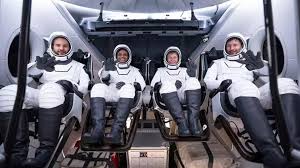Dragon with Shukla, 3 others to dock with ISS at 4.30 pm today

Indian Air Force’s Group Captain Shubhanshu Shukla is all set to make history as the SpaceX Crew Dragon prepares to dock with the International Space Station this evening.
A New Chapter in India’s Space Journey
Today, India is preparing to witness a moment of pride and scientific progress. At 4:30 PM IST, SpaceX’s Crew Dragon spacecraft is scheduled to dock with the International Space Station (ISS), carrying on board Group Captain Shubhanshu Shukla—a decorated Indian Air Force officer.
This event marks the first time an Indian national will set foot aboard the ISS, ushering in a new era for the country’s space ambitions.
Meet the Crew on Board
Besides Group Captain Shukla, the Crew Dragon capsule carries three other astronauts:
- Peggy Whitson (USA) – A veteran astronaut and the first woman to command the ISS twice.
- Sławosz Uznanski (Poland) – A European Space Agency astronaut and electrical engineer.
- Tibor Kapu (Hungary) – A spaceflight participant from Hungary, representing his country’s renewed space efforts.
Together, this multinational crew highlights the spirit of global cooperation in advancing space research.
The Mission: Axiom-4’s Broader Goals
The current mission, known as Axiom Mission 4 (Ax-4), launched on June 25 at 12:01 PM IST from NASA’s Kennedy Space Center. Although the docking is scheduled for today, the crew’s objectives go far beyond reaching the ISS.
Unlike purely symbolic flights, this mission focuses heavily on scientific exploration. During their planned two-week stay, the astronauts will conduct a wide range of experiments, many of which are designed by Indian scientists and institutions.
Why This Docking Is So Critical
The docking process, although mostly automated, is a high-stakes maneuver that demands precision. Here’s how it works:
- Initial Approach: The capsule gradually aligns with the ISS’s Harmony module.
- Soft Capture: Magnetic components gently connect the spacecraft to the station.
- Hard Capture: Mechanical latches secure the link between the two structures.
- Pressurization & Hatch Opening: Once the pressure is equalized, the crew can safely enter the ISS.
NASA and Axiom Space are providing live coverage, starting at 2:30 PM IST. You can watch it on NASA’s official YouTube channel or Axiom Space’s website.
Shubhanshu Shukla: A New Face of Indian Space Ambition
Group Captain Shukla’s participation in this mission is a defining moment for India’s space aspirations. Previously trained in Russia and the United States, Shukla represents a new generation of Indian astronauts.
Unlike Rakesh Sharma’s 1984 mission—which was part of a Soviet program—Shukla’s journey is part of a global private-public collaboration, showcasing India’s evolving strategy in space diplomacy and innovation.
Indian Experiments to Begin Aboard the ISS
Notably, Shukla will also conduct seven Indian-designed experiments in microgravity, developed by the Indian Space Research Organisation (ISRO) and academic institutions. These studies include:
- Observing microbial growth in zero gravity
- Analyzing human cardiovascular responses
- Testing materials for space durability
These experiments are expected to contribute significantly to India’s upcoming Gaganyaan mission, while also offering insights relevant to international space medicine and technology.
What to Expect After Docking
Once the docking is complete, the crew will enter the ISS and begin their routine. The schedule includes:
- Health and safety briefings
- Equipment orientation and station integration
- Immediate commencement of scientific experiments
- Live outreach sessions with schools and universities
This direct engagement with educational institutions will inspire students not just in India but across participating countries.
India’s Strategic Space Positioning
India’s involvement in Ax-4 highlights a broader shift in global space strategy. Rather than working in isolation, space agencies and governments are now leaning into partnerships with private companies like SpaceX and Axiom Space.
By participating in this mission, India demonstrates that it is not just catching up but actively shaping the future of global space missions.
Furthermore, it lays the groundwork for more Indian astronauts to collaborate internationally, making extended space research more accessible and feasible.
A Mission Beyond Borders
Today’s docking is far more than a technological feat. It stands as a symbol of cross-cultural and scientific collaboration, one where a test pilot from India joins seasoned astronauts to push humanity’s boundaries.
As the world watches at 4:30 PM IST, this mission reminds us that space exploration is no longer limited to superpowers—it’s a shared journey that transcends borders.
Conclusion: India’s Place in the Stars
As Shubhanshu Shukla prepares to step into the ISS, he takes not just a personal leap but carries with him the hopes of a billion Indians. His mission bridges science, diplomacy, and dreams.
Indeed, when the Crew Dragon docks today, it won’t just be a spacecraft connecting with a station. It will be a defining moment connecting India with the global future of space exploration.






